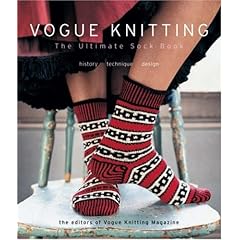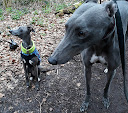 I always had a problem getting the point of lace knitting. Well, it looks pretty and it is delicate but there just seems to be so many other ways of making lace that made so much more sense than actually knitting it. To produce even the most simplest of 'holes' in the fabric of knitting, seems such a complicated issue compared with just picking up a crochet hook, and the 'holes' just being there as part of the stitch.
I always had a problem getting the point of lace knitting. Well, it looks pretty and it is delicate but there just seems to be so many other ways of making lace that made so much more sense than actually knitting it. To produce even the most simplest of 'holes' in the fabric of knitting, seems such a complicated issue compared with just picking up a crochet hook, and the 'holes' just being there as part of the stitch.Every time I have taken a complicated lace stitch pattern from a library I always felt after a few rows that even a chimp could follow the instructions stitch by stitch and get a result, but that didn't mean they understood it. So, whether it is the lack of lace making that made me weak in this area of design, or whether it was just such a complicated thing hardly anyone could get, I just couldn't decide. I had tried explaining how I felt about this to other knitters, and they might assure me that it was easy etc, but however much I knitted lace, things didn't really fall into place.
I have always been happy about picking a lace 'block' or panel, and tweaking it into a design, but I think what really bugged me was this. In order to 'design' a sweater or garment with colour work, designers are not supposed to pick out patterns from books and slot them in, I have always had great pressure on me to invent my own colour charts, and anything more complicated than stripes, would have to be totally original. Then when I moved over to the equivalent of lace design, I have rarely found anyone who could go beyond the understanding of an existing piece, and totally make up their own stitch patterns from scratch.
So I jumped at the chance to go to an Amy Singer introduction to lace workshop, thinking perhaps there was something missing from skills set. So on Sunday, I went, and didn't find any magic answers to designing in lace, but definitely felt more confident in being able to read my lace, and loved Amy's approach of adapting lace stitches to be easy and memorable...and I thought, yes, that is what I need to accept, is that sometimes the most simple and easy patterns are the most popular and the most beautiful, and if I decide to design something using a lace motif or stitch, then I don't need to feel in any way inadequate if it isn't complicated and isn't so complicated that no-one can attempt it.
I often feel a fraud as a 'designer', after all, I have not formally studied this craft and anything I know is just years of fiddling about. In fact, when I got back into knitting again after a long break it was with the understanding that I cannot push myself into anything taxing as the brain power is not there (drugs and illness), the dexterity isn't there either (drugs and illness). So what on earth am I doing now, beating myself up over skills I don't seem to be as strong in compared with others?
All this thought of lace knitting recently. rather than making me go into more complicated knitting or designing, is actually leading me back to simple and pure is best. You know how you can just pick up something like a garter stitch scarf, in a beautiful shade and yarn, and it just seems so right? It doesn't matter if garter stitch is a beginner stitch and a scarf has no shaping, the thing is just right to wear. This principle I am going to apply to me and lace and anything else I do...simple is best, and rather than go up a blind alley of specialisation, I am going to remain an inexperienced dabbler. Literally Jack of all Trades and Master of None...that suits me!
I just don't want too many people to get hung up on that word 'designer', so I might drop that and just say 'crafter' instead, and provided my craft works are original, then I can publish them (or perhaps not..it doesn't really matter).












































